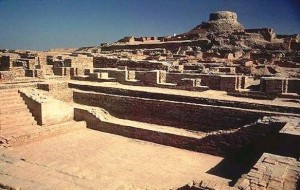
Located in the western region of South Asia, and spread over what are now Pakistan, northwest India, and eastern Afghanistan, was the once flourishing Indus Valley Civilization or the Harappan civilization as it’s also referred to, by the the city of Harappa, which was the first excavated city. The Harappan was one of the first attested ancient civilizations, alongside Mesopotamia and Ancient Egypt, which demonstrated incredibly advanced social structure and urban planning through out its history which started 6000 years ago and ended some 3500 years ago. The civilization was spread over some 1,260,000 km², making it the largest ancient civilization.
Various theories have emerged concerning its demise, however, a recently published study in the journal Proceedings of the National Academy of Sciences, proves that climate change which caused drought in otherwise monsoon-based neighboring rivers ultimately crippled the Harappan. The team of researchers involved in the study was comprised of geologists and archeologists from the U.S., U.K., Pakistan, India, and Romania.
“We reconstructed the dynamic landscape of the plain where the Indus civilization developed 5200 years ago, built its cities, and slowly disintegrated between 3900 and 3000 years ago,” said Liviu Giosan, a geologist with Woods Hole Oceanographic Institution and lead author of the study. “Until now, speculations abounded about the links between this mysterious ancient culture and its life-giving mighty rivers.”

The researchers used topographic data and satellite photos, to digitally map the landforms artificially produced by the Indus population and naturally by the neighboring rivers, which were subsequently sampled through drilling, coring and manually-dug trenches. These samples were used to determine the sediments’ makeup, age and origins.
Separate, archeological evidence, showed that the Harappan civilization developed a highly complex society that included a sophisticated urban culture, intricate trade trades, and a currently-undeciphered writing system.
“They had cities ordered into grids, with exquisite plumbing, which was not encountered again until the Romans,” said Giosan. “They seem to have been a more democratic society than Mesopotamia and Egypt — no large structures were built for important personalities like kings or pharaohs.”
The researchers found that during one time frame, the region inhabited by the Harappan was prone to devastating floods via monsoons. In time, these monsoons weakened, enabling agriculture to develop and ultimately led the Harappan to flourish along the riverbanks for some 2,000 years. The whole civilization was dependent on the seasonal river floods, and it was no surprise to the researchers when they found that over-time, these monsoon-based rivers, which held too little water, dried up, making them unfavorable for civilization. Eventually, over the course of centuries, Harappans fled along an escape route to the east toward the Ganges basin, where monsoon rains remained reliable, the study suggests.
The scientists believe this study is not only important as a window in history describing the context under which one of man’s most ancient civilizations rose and fell, but also serves as an idication of what current weather patterns might mean for this swath of Asia.
“If we take the devastating floods that caused the largest humanitarian disaster in Pakistan’s history as a sign of increased monsoon activity, than this doesn’t bode well for the region,” Giosan told LiveScience. “The region has the largest irrigation scheme in the world, and all those dams and channels would become obsolete in the face of the large floods an increased monsoon would bring.”
via redorbit



